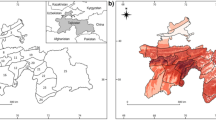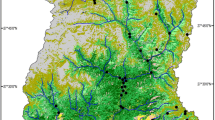Abstract
We describe the elevational patterns of species richness and endemism of some important taxa in the Hengduan Mountains, southwest China. Species richness data came from publications, an online database, herbaria and field work. Species richness was estimated by rarefaction and interpolation. The Hengduan Mountains region was divided into a southern and northern subregion, and all species were assigned to four groups based on their distributional range within this region. The conditional autoregressive model (CAR) was used to relate species richness and explanatory variables. The elevational patterns of total, endemic and non-endemic species richness, at subregion and entire region scales, presented to be unimodal and peaked at similar elevations. Area size was strongly related with species richness, and was more powerful in explaining variation in species richness in the northern subregion than in the southern subregion. A single climatic variable (mean annual rainfall, potential evapotranspiration or moisture index) showed a weak relationship with the elevational pattern of species richness. Area and climatic variables together explained more than 67% of the variation in non-endemic richness, 53% in total richness, and 50% in endemic richness. There were three patterns of endemism at the generic level with increasing elevation: namely endemism increased, decreased, or peaked at middle elevations. All selected taxa have experienced rapid speciation and evolution within this region, which plays an important role in the uniform elevational patterns of total, endemic and non-endemic richness, and in the multiform elevational patterns of endemism.






Similar content being viewed by others
References
Bachman S, Baker WJ, Brummitt N et al (2004) Elevational gradient, area and tropical island biodiversity: an example from the palms of New Guinea. Ecography 27:299–310. doi:10.1111/j.0906-7590.2004.03759.x
Bhattarai KR, Vetaas OR (2003) Variation in plant species richness of different life forms along a subtropical elevational gradient in the Himalayas, east Nepal. Glob Ecol Biogeogr 12:327–340. doi:10.1046/j.1466-822X.2003.00044.x
Bhattarai KR, Vetaas OR, Grytnes JA (2004) Fern species richness along a central Himalayan elevational gradient. Nepal J Biogeogr 31:389–400
Boufford DE, Dijk PPV (2000) South-Central China. In: Mittermeier RA, Myers N, Mittermeier CG (eds) Hotspots: earth’s biologically richest and most endangered terrestrial ecoregions. Cemex, Mexico
Boufford DE, Dijk PPV, Zhi L (2004) Mountains of Southwest China. In: Mittermeier RA, Robles-Gil P, Hoffmann M et al (eds) Hotspots revisited: earth’s biologically richest and most endangered ecoregions, 2nd edn. Cemex, Mexico
Carpenter C (2005) The environmental control of plant species density on a Himalayan elevational gradient. J Biogeogr 32:999–1018. doi:10.1111/j.1365-2699.2005.01249.x
Fang JY (2004) Exploring altitudinal patterns of plant species diversity of China’s mountains. Biodivers Sci 12:1–4
Fu CZ, Hua X, Li J et al (2006) Elevational patterns of frog species richness and endemic richness in the Hengduan Mountains, China: geometric constraints, area and climate effects. Ecography 29:919–927. doi:10.1111/j.2006.0906-7590.04802.x
Grytnes JA, Beaman JH (2006) Elevational species richness patterns for vascular plants on Mount Kinabalu, Borneo. J Biogeogr 33:1838–1849. doi:10.1111/j.1365-2699.2006.01554.x
Hegazy AK, El-Demerdash MA, Hosni HA (1998) Vegetation, species diversity and floristic relations along an altitudinal gradient in south-west Saudi Arabia. J Arid Environ 38:3–13. doi:10.1006/jare.1997.0311
Hofierka J, Parajka J, Mitasova H et al (2002) Multivariate interpolation of precipitation using regularized spline with tension. Trans GIS 6(2):135–150. doi:10.1111/1467-9671.00101
Holdrige LR (1947) Determination of world plant formation from simple climate data. Science 105:367–368. doi:10.1126/science.105.2727.367
Holdrige LR (1976) Life zone ecology. Tropical Science Center, San Jose
Ibisch PL, Boegner A, Nieder J et al (1996) How diverse are neotropical epiphytes? an analysis based on the ‘Catalogue of the flowering plants and gymnosperms of Peru’. Ecotropica 1:13–28
Jankowski T, Weyhenmeyer GA (2006) The role of spatial scale and area in determining richness-altitude gradients in Swedish lake phytoplankton communities. Oikos 115:433–442. doi:10.1111/j.2006.0030-1299.15295.x
Jetz W, Rahbek C (2002) Geographic range size and determinants of avian species richness. Science 297:1548–1551. doi:10.1126/science.1072779
Karnieli A (1990) Application of kriging technique to areal precipitation mapping in Arizona. GeoJournal 22:391–398. doi:10.1007/BF00174760
Kessler M (2002) The elevational gradient of Andean plant endemism: varying influences of taxon-specific traits and topography at different taxonomic levels. J Biogeogr 29:1159–1165. doi:10.1046/j.1365-2699.2002.00773.x
Kessler M, Herzog SK, Fjeldså J et al (2001) Species richness and endemism of plant and bird communities along two gradients of elevational, humidity, and land use in the Bolivian Andes. Divers Distrib 7:61–77. doi:10.1046/j.1472-4642.2001.00097.x
Kluge J, Kessler M, Dunn RR (2006) What drives elevational patterns of diversity? A test of geometric constraints, climates and species pool effects for pteridophytes on an elevational gradient in Costa Rica. Glob Ecol Biogeogr 15:358–371. doi:10.1111/j.1466-822X.2006.00223.x
Krömer T, Kessler M, Gradstein SR et al (2005) Diversity patterns of vascular epiphytes along an elevational gradient in the Andes. J Biogeogr 32:1799–1809. doi:10.1111/j.1365-2699.2005.01318.x
Li BY (1987) On the boundaries of the Hengduan Mountains. Mt Res 5(2):74–82
Li BY (1989) Geomorphologic regionalization of the Hengduan Mountainous region. Mt Res 7(1):13–20
Li ZW, Chen ZR, Wang ML (1991) Classification and correlation of the quaternary glacial epoch in the Hengduan (Transverse) Mountains. Geol Rev 37:125–132
Liu LH, Yu YD, Zhang JH (1984) The division of vertical vegetation zone in Hengduanshan. Acta Bot Yunnanica 6:205–216
Liu LH, Yu YD, Zhang JH (1985) Discussion upon the regularities of vegetational distribution in the Hengduan Mountains. Acta Bot Yunnanica 7:323–335
Liu ZL, Fang JY, Piao SL (2002) Geographical distribution of species in genera Abies, Picea and Larix in China. Acta Geogr Sin 57:577–586
Liu JQ, Wang YJ, Wang AL et al (2006) Radiation and diversification within the ligularia-cremanthodium-parasenecio complex (Asteraceae) triggered by uplift of the Qinghai-Tibetan Plateau. Mol Phylogenet Evol 38:31–49. doi:10.1016/j.ympev.2005.09.010
Lomolino MV (2001) Elevational gradients of species-density: historical and prospective views. Glob Ecol Biogeogr 10:3–13. doi:10.1046/j.1466-822x.2001.00229.x
Luo Y, Zhang FM, Yang QE (2005) Phylogeny of Aconitum subgenus Aconitum (Ranunculaceae) inferred from ITS sequences. Plant Syst Evol 252:11–25. doi:10.1007/s00606-004-0257-5
MacArthur RH (1972) Geographical ecology: patterns of the distribution of species. Harper and Row, New York
McGlone MS, Duncan RP, Heenan PB (2001) Endemism, species selection and the origin and distribution of the vascular plant flora of New Zealand. J Biogeogr 28:199–216. doi:10.1046/j.1365-2699.2001.00525.x
Mora C, Robertson DR (2005) Causes of latitudinal gradients in species richness: a test with fishes of the tropical eastern pacific. Ecology 86:1771–1782. doi:10.1890/04-0883
Myers N, Mittermeier RA, Mittermeier CG et al (2000) Biodiversity hotspots for conservation priorities. Nature 403:853–858. doi:10.1038/35002501
Oommen MA, Shanker K (2005) Elevational species richness patterns emerge from multiple local mechanisms in Himalayan woody plants. Ecology 86:3039–3047. doi:10.1890/04-1837
Rahbek C (2005) The role of spatial scale and the perception of large-scale species richness patterns. Ecol Lett 8:224–239. doi:10.1111/j.1461-0248.2004.00701.x
Rangel TFLVB, Diniz-Filho JAF, Bini LM (2006) Towards an integrated computational tool for spatial analysis in macroecology and biogeography. Glob Ecol Biogeogr 15:321–327. doi:10.1111/j.1466-822X.2006.00237.x
Sánchez-González A, López-Mata L (2005) Plant species richness and diversity along an altitude gradient in the Sierra Nevada, Mexico. Divers Distrib 11:567–575. doi:10.1111/j.1366-9516.2005.00186.x
Sanders NJ (2002) Elevational gradients in ant species richness: area, geometry, and Rapoport’s rule. Ecography 25:25–32. doi:10.1034/j.1600-0587.2002.250104.x
Schoener TW (1976) The species-area relationship within archipelagoes: models and evidence from island land birds. In: Proceedings of the XVI International Ornithological Congress, vol 6. pp 629–642
Shen ZH, Fang JY, Liu ZL et al (2001) Pattern of biodiversity along the vertical vegetation spectrum of the east aspect of Gongga Mountain. Acta Phytoecol Sin 25:721–732
Sun H (2002) Evolution of Arctic-Tertiary flora in Himalayan-Hengduan Mountains. Acta Bot Yunnanica 24:671–688
Sun H, Li ZM (2003) Qinghai-Tibet Plateau uplift and its impact on Tethys flora. Adv Earth Sci 18:852–862
Trewick SA, Wallis GP, Morgan-Richards M (2000) Phylogeographical pattern correlates with Pliocene mountain building in the alpine scree weta (Orthoptera, Anostostomatidae). Mol Ecol 9:657–666. doi:10.1046/j.1365-294x.2000.00905.x
Vetaas OR, Grytnes JA (2002) Distribution of vascular plant species richness and endemic richness along the Himalayan elevational gradient in Nepal. Glob Ecol Biogeogr 11:291–301. doi:10.1046/j.1466-822X.2002.00297.x
Walter H (1979) Vegetation of the earth ecological system of the geobiosphere, 2nd edn. Springer-Verlag, New York
Wang WT (1993, 1994) Vascular plants of the Hengduan Mountains (vol. 1 and 2). Science Press, Beijing
Wang YJ, Liu JQ (2004) A preliminary investigation on the phylogeny of Saussurea (Asteraceae: Cardueae) based on chloroplast DNA trn L-F sequences. Acta Phytotaxon Sin 42(2):136–153
Wu ZY (1988) The Hengduan Mountain flora and her significance. J Jpn Bot 63(9):1–14
Yu YD, Liu LH, Zhang JH (1989) Vegetation regionalization of the Hengduan Mountain region. Mt Res 7(1):47–55
Zhang DC, Sun H (2007) Division of the southern and northern subregions in the Hengduan Mountains and their species richness. Newsl Himal Bot 40:15–19
Zhang RZ, Zheng D, Yang QY et al (1997) Physical geography of Hengduan Mountains. Science Press, Beijing
Zhang FM, Ge S, Chen WL (2003) Phylogeny of the Aconitum delavayi complex (Ranunculaceae) based on evidence from nuclear ribosomal ITS sequences. Acta Phytotaxon Sin 41(3):220–228
Zhao CM, Chen WL, Tian ZQ et al (2005) Altitudinal pattern of plant species diversity in Shennongjia Mountains, Central China. J Integr Plant Biol 47:1431–1449. doi:10.1111/j.1744-7909.2005.00164.x
Acknowledgments
We are indebted to Roy Turkington and Susan Kelley for editing the manuscript. The manuscript was improved from comments by reviewers and Richard H. Ree. This study was supported by grants from the National 973 Project (grant no. 2007CB411601), the Natural Science Foundation of China (grant no. 30625004, 40771073 to H. Sun), and the Fund of Key Laboratory of Biodiversity and Biogeography, Kunming institute of botany, Chinese Academy of Sciences (grant no. 0806331121), and the U.S. National Science Foundation (grant no. DEB-0321846 to David E. Boufford).
Author information
Authors and Affiliations
Corresponding author
Electronic supplementary material
Below is the link to the electronic supplementary material.
Rights and permissions
About this article
Cite this article
Zhang, DC., Zhang, YH., Boufford, D.E. et al. Elevational patterns of species richness and endemism for some important taxa in the Hengduan Mountains, southwestern China. Biodivers Conserv 18, 699–716 (2009). https://doi.org/10.1007/s10531-008-9534-x
Received:
Accepted:
Published:
Issue Date:
DOI: https://doi.org/10.1007/s10531-008-9534-x




